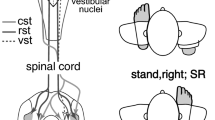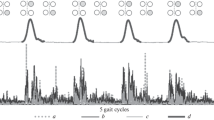Abstract
Transcranial magnetic stimulation (TMS) of the motor cortex was applied during locomotion to investigate the significance of corticospinal input upon the gait pattern. Evoked motor responses (EMR) were studied in the electromyogram (EMG) of tibialis anterior (TA), gastrocnemius (GM) and, for reference, abductor digiti minimi (AD) muscles by applying below-threshold magnetic stimuli during treadmill walking in healthy adults. Averages of 15 stimuli introduced randomly at each of 16 phases of the stride cycle were analysed. Phase-dependent amplitude modulation of EMR was present in TA and GM which did not always parallel the gait-associated modulation of the EMG activity. No variation of onset latency of the EMR was observed. The net modulatory response was calculated by comparing EMR amplitudes during gait with EMR amplitudes obtained (at corresponding background EMG activities) during tonic voluntary muscle contraction. Large net responses in both muscles occurred prior to or during phasic changes of EMG activity in the locomotor pattern. This facilitation of EMR was significantly higher in leg flexor than extensor muscles, with maxima in TA prior to and during late swing phase. A comparison of this facilitation of TA EMR prior to swing phase and prior to a phasic voluntary foot dorsiflexion revealed a similar onset but an increased amount of early facilitation in the gait condition. The modulated facilitation of EMR during locomotion could in part be explained by spinal effects which are different under dynamic and static motor conditions. However, we suggest that changes in corticospinal excitability during gait are also reflected in this facilitation. This suggestion is based on: (1) the similar onset yet dissimilar size of facilitatory effects in TA EMR prior to the swing phase of the stride cycle and during a voluntary dynamic activation, (2) the inverse variation of EMR and EMG amplitudes during this phase, and (3) the occurrence of this inversion at stimulation strengths below motor threshold (motor threshold was determined during weak tonic contraction and EMR were facilitated during gait). It is hypothesized that the facilitation is phase linked to ensure postural stability and is most effective during the phases prior to and during rhythmical activation of the leg muscles resulting in anticipatory adjustment of the locomotor pattern.
Similar content being viewed by others
Author information
Authors and Affiliations
Additional information
Received: 17 May 1996 / Accepted: 29 November 1996
Rights and permissions
About this article
Cite this article
Schubert, M., Curt, A., Jensen, L. et al. Corticospinal input in human gait: modulation of magnetically evoked motor responses. Exp Brain Res 115, 234–246 (1997). https://doi.org/10.1007/PL00005693
Issue Date:
DOI: https://doi.org/10.1007/PL00005693




